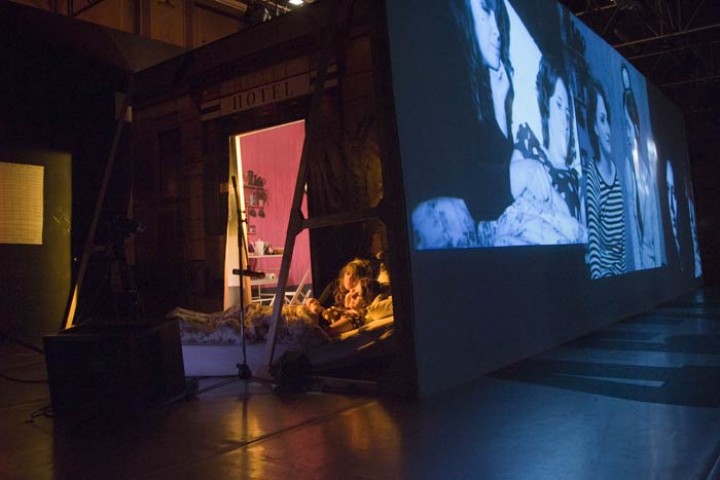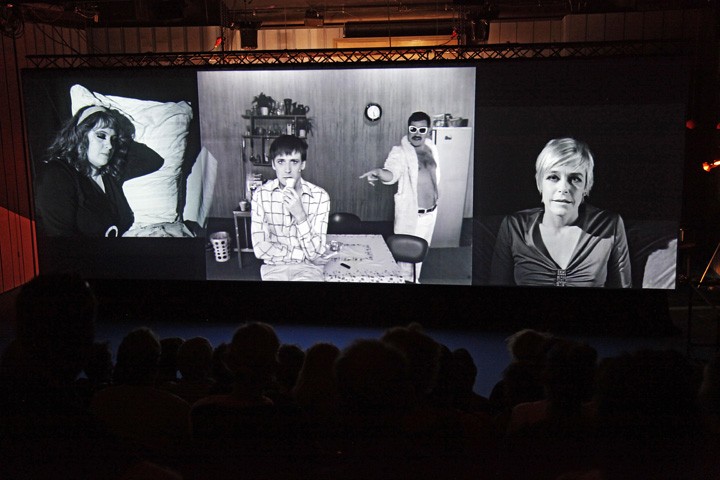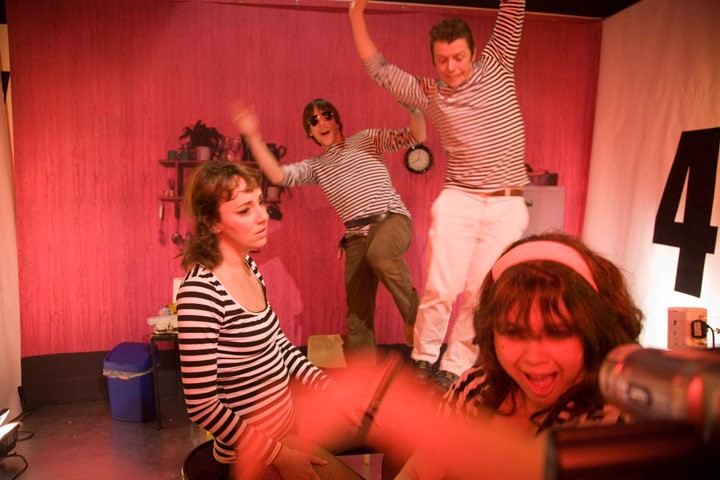The scenic design of Kitchen is fairly straightforward. There are adjacent three large screens on which images are projected; these are all that is visible from the audience seating. Behind these screens are sets and cameras; the stage left third contains a chair and lighting, the center third a realistic kitchen set and cameras, the stage right third a bed and camera. The audience enters the performance space by first traversing the backstage area, checking out these mechanisms for image production before moving to their assigned seats for the performance. When the live images appear on the screens, it is understood that they are being produced just feet behind the projection surfaces.
The performers begin to reenact scenes from Warhol’s films, then interrupt themselves to talk and argue amongst themselves about their struggles to capture this specific cultural moment. Why this time? Why these films? What was it about Warhol’s work that is so emblematic of the 1960s counterculture, and why should that moment be privileged? The spoken text is explicit and discursive, as group members each attempt to refocus the piece to conform to their own sense of what made this cultural moment significant and special. We see the process by which this piece was arrived at made visible within the performance itself, a tactic common to postdramatic theatre. This tactic unfolds on multiple layers: in the expository speeches and the naked attempts, framed as such, to appropriate Warhol’s footage; in the argumentative dialogues regarding the success and failure of each of these attempts; in the mechanism of the image production, revealed so clearly by the pre-show traversal of the backstage production space.
Much of the text turns on a discussion of authenticity. It is this quality, members of Gob Squad claim, that distinguishes Warhol’s work and by extension the project of the counter-cultural movement just beginning to emerge in 1965, when Kitchen was originally shot. How to get more of reality, the real sense and texture of lived experience, into art? The performers’ attempts, modeled after Warhol’s cinematic tactics, center around capturing casual, unrehearsed behavior, naked emotional truth, and by all means, ‘non-acting’. These attempts become more comic and frustrated as the piece goes on, as the futility of constructing ‘casual’ moments becomes more evident. The group’s knowledge and understanding of the cultural project they are attempting to emulate begins to seem more and more shallow, the attempt more and more misguided.
Finally, in frustration, one of the performers leaves the frame of the soundstage and storms onstage, in front of the projection surfaces. They stalk into the audience and choose an audience member seemingly at random; to this audience member they give a headset and a push onstage while they disappear into the audience. It becomes clear that this member of Gob Squad has ‘replaced’ himself with an audience proxy, who is now receiving instructions about where to go and what to say via headset. Partly flummoxed, partly game, and with seemingly no real alternatives (the show must go on), the remaining members of Gob Squad still onstage engage with their compatriot’s proxy as though nothing has changed. Of course, this injection of unpredictable and unrehearsed behavior provides exactly the kind of ‘authenticity’ that was lamented as absent and unattainable in the first part of the piece. Another performer decides that she wants to replace herself with an audience proxy; she finds her replacement in the audience and sends them onstage equipped with a headset. From the audience now, these partly absent members of Gob Squad murmur instructions into microphones, guiding their ‘actors’ through the motions of the performance.
The shock of seeing an audience member ‘like oneself’ not just onstage, but situated within and incorporated fully into a media landscape of such specific aesthetic and cultural connotation dislocates the performance experience into a new level of presence and complexity. In modern dress but period sets and media aesthetic, the juxtapositions both visually and textually evoke simultaneously the distance and the proximity of this 1965 cultural moment and our own. The entire theatre space is activated, as the auditorium is made volatile, a place where one might not only be seen from the stage (the inverse of a traditional performance situation) but invited up onto it and guided through a performance in which one becomes the center of attention.
Gob Squad manages this interaction with sensitivity and intelligence. The face that these audience participants/actor proxies are taken onto the set means that they cannot see the audience, freeing them from a certain level of performance anxiety. They are held within a safety blanket of action and certainty by the instructions delivered to them over their headphones, meaning that they are never pressured to devise content. Finally, the actions they are asked to perform are at least at surface level pedestrian and everyday—laying down on a bed with someone, sitting in a kitchen and eating, facing a camera and answering simple questions about themselves. Sometimes it is clear that they are reciting words that are being transmitted to them over their headsets; other times it seems as though they themselves are speaking spontaneously.
By the end of the performance, not a single member of Gob Squad remains onstage; the proxies complete the performance. Somehow it is all deeply affecting.
The mastery displayed by Gob Squad in this work is manifest on several planes having to do with the notion of expanded theatre: expressive and effective use of architecture and physical space, creating meaning through both the form and content of moving image media, and designing and executing sophisticated interactions with audience-participants.
Kitchen (You’ve Never Had it So Good) is a hugely popular piece for Gob Squad; it toured as recently as 2014 (and may tour again). In 2012 it won a Drama Desk award (NYC) for Unique Theatrical Experience.
]]>


